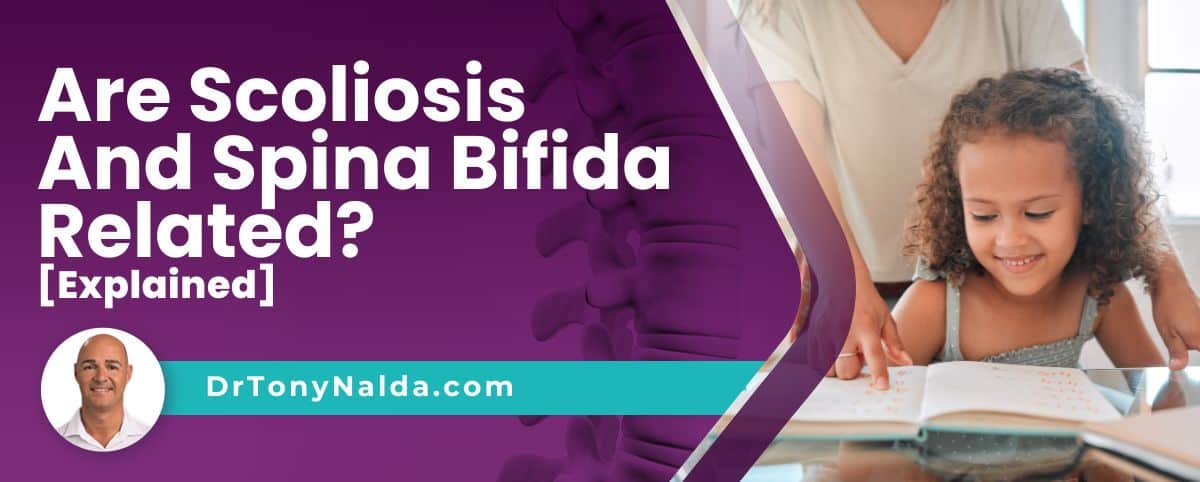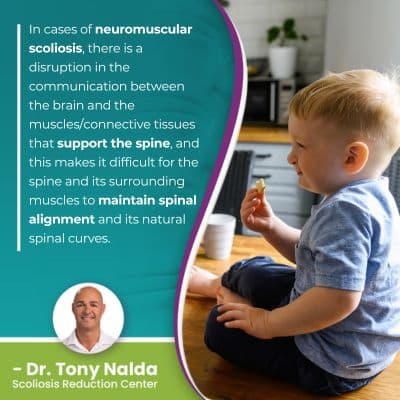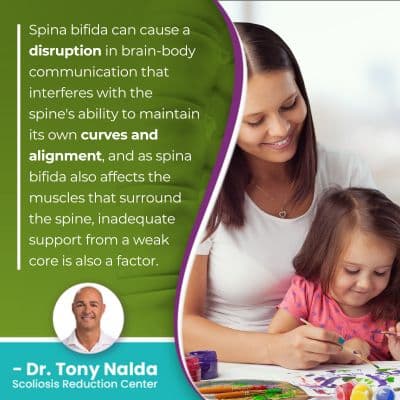Are Scoliosis And Spina Bifida Related? [Explained]

Scoliosis and spina bifida are both prevalent conditions that affect the spine, it surroundings, and the central nervous system (CNS) and warrant awareness; it's estimated that approximately 50 percent of people with spina bifida will develop neuromuscular scoliosis as a related complication.
Scoliosis involves the development of an unnatural spinal curve, and spina bifida occulta is a neuromuscular condition caused by a neural tube defect that prevents the spine from forming properly. Spina bifida can cause the development of neuromuscular scoliosis: an atypical condition type.
Before getting to the connection between scoliosis and spina bifida, let's first define the conditions.
Table of Contents
What is Scoliosis?
Current estimates have close to seven million people living with scoliosis in the United States alone.
Being diagnosed with scoliosis means an unnatural sideways curvature of the spine that also rotates has developed, and as a progressive condition, the nature of scoliosis is to get worse over time.
It's growth spurts that trigger scoliosis progression, which is why childhood scoliosis should be taken seriously, and childhood scoliosis treatment focuses on how best to counteract the condition's progressive nature throughout growth.
While adults have the progressive trigger of growth removed, they can still progress over time, particularly once natural age-related spinal degeneration comes into play; in fact, the actual rate of scoliosis increases with age.
Scoliosis is a highly-variable condition; no two cases are the same, which is why the complex nature necessitates the complete customization of effective treatment plans.
Scoliosis ranges in severity and type and affects all ages, but the most prevalent type overall is adolescent idiopathic scoliosis, diagnosed between the ages of 10 and 18; adolescents are the most at risk for rapid-phase progression because of the rapid and unpredictable growth spurts of puberty.
The majority of scoliosis cases, approximately 80 percent, involve idiopathic scoliosis, meaning cause unknown, and the remaining 20 percent are associated with known causes: neuromuscular scoliosis, congenital scoliosis, and degenerative scoliosis.
Curve progression can be managed effectively through proactive conservative treatment, but there are no treatment guarantees, and for those on the route of traditional scoliosis treatment, spinal fusion surgery is the common response, and this can disrupt the spine's long-term health, strength, and function.
Scoliosis ranges in severity from mild scoliosis to moderate, severe, and very severe scoliosis, and as the condition progresses, it becomes more severe, and its effects tend to become more noticeable.
The main symptom of scoliosis in children is postural changes, and the main symptom of scoliosis in adults is pain: back pain and/or pain that radiates into the extremities due to nerve damage caused by compression.
What is Spina Bifida?
Spina bifida is a neuromuscular condition that's caused by neural tube defects that interfere with proper formation of the spine and spinal cord; in cases of congenital scoliosis, the scoliosis is caused by spinal malformations that occur in utero as the spine is forming, but spina bifida is more closely tied to the development of neuromuscular scoliosis.
Because of the defect in the neural tube, a gap forms in the spine, and as the neural tube eventually forms into the brain and spinal cord, a defect will affect the brain and/or spinal cord, and as the brain and spine work together to form the body's central nervous system (CNS), communication within the body is also affected.
The central nervous system is a vast communication network that facilitates brain-body communication so is involved in the function of virtually every working system within the body.
Each year, approximately 1,400 babies are born with spina bifida, so one out of every 2,700 babies born in a year, one is born with spina bifida in the United States.
The strongest link between scoliosis and spina bifida involves neuromuscular scoliosis, so let's explore that connection.
Neuromuscular Scoliosis in Spina Bifida
 In typical cases of idiopathic scoliosis, the scoliotic curve bends to the right, away from the heart, but in atypical condition types with known causes, such as neuromuscular scoliosis (NMS), curves can bend to the left, towards the heart, and when I see this in an X-ray, I know there is an underlying pathology that's caused the scoliosis to develop.
In typical cases of idiopathic scoliosis, the scoliotic curve bends to the right, away from the heart, but in atypical condition types with known causes, such as neuromuscular scoliosis (NMS), curves can bend to the left, towards the heart, and when I see this in an X-ray, I know there is an underlying pathology that's caused the scoliosis to develop.
In addition to spina bifida, there are a number of neuromuscular conditions that can cause the development of neuromuscular scoliosis such as cerebral palsy, muscular dystrophy, and myelodysplasia
In neuromuscular scoliosis caused by spinal bifida, the neuromuscular condition has caused the scoliosis to develop as a secondary complication.
While not everyone with a neuromuscular condition will develop scoliosis, it is a common complication that affects approximately 50 percent of people living with spina bifida, and the likelihood that a child will develop NMS depends on the degree of nerve and muscle involvement.
For children who are nonambulatory (wheelchair bound and unable to walk on their own), they are the most likely to develop NMS.
In cases of neuromuscular scoliosis, there is a disruption to the communication between the brain and the muscles/connective tissues that support the spine, and this makes it difficult for the spine and its surrounding muscles to maintain its alignment and the spine's natural curves.
If spina bifida is present, this is the larger condition that has to be the focus of treatment, so this can complicate the treatment process; how is neuromuscular scoliosis treated?
Neuromuscular Scoliosis Treatment Options
When it comes to atypical condition types, such as NMS, these cases tend to be severe, and when neurological problems have caused the incomplete closure of the neural tube, additional abnormalities can also be present.
In many congenital conditions, there are additional congenital abnormalities that need to be comprehensively assessed and monitored, as is the case with congenital scoliosis.
Spina bifida can cause a disruption in brain-body communication that interferes with the spine's ability to maintain its own curves and alignment, and as spina bifida also affects the muscles that surround the spine, inadequate support from a weak core is also a factor.
When treating typical cases of scoliosis, increasing core strength through physical therapy and scoliosis-specific exercise is a key facet of treatment, and as scoliosis progresses, the spine gets increasingly rigid, making it less responsive to treatment, and making it difficult for some patient to perform key therapeutic exercises as part of treatment.
In these types of cases, the underlying condition causing the scoliosis has to guide treatment, and my NMS patients are among the hardest to treat, and many are children whose scoliosis is going to progress with growth.
 When it comes to addressing neuromuscular scoliosis with treatment, this can involve condition-specific chiropractic care and physical therapy that works towards making improvements to a patient's overall quality of life, and in severe cases, surgical treatment can be recommended.
When it comes to addressing neuromuscular scoliosis with treatment, this can involve condition-specific chiropractic care and physical therapy that works towards making improvements to a patient's overall quality of life, and in severe cases, surgical treatment can be recommended.
Conclusion
Scoliosis is a complex progressive spinal condition that can range from mild to moderate and severe to very severe, but regardless of severity, the best time to start treatment is always now; as a progressive condition, it only gets more complex to treat the more it progresses.
There are also multiple different types of scoliosis a person can develop, and the most common type is idiopathic scoliosis, and the atypical types are those associated with known causes: neuromuscular scoliosis, degenerative scoliosis, and congenital scoliosis.
Degenerative scoliosis is caused by natural age-related spinal degeneration. Congenital scoliosis develops as the spine doesn't form properly in utero so babies are born with the condition, and in cases of neuromuscular scoliosis, the scoliosis is caused by the presence of a larger neuromuscular condition like cerebral palsy, muscular dystrophy, and spina bifida occulta.
The more severe a condition is, the more noticeable its effects are likely to be, and posture, balance, coordination, and gait can be disrupted.
In order to correct scoliosis, here at the Scoliosis Reduction Center, cases of typical idiopathic scoliosis are addressed proactively by starting treatment immediately and by integrating multiple conservative treatment discipline so conditions can be impacted on every level: chiropractic care, physical therapy, corrective bracing, and rehabilitation.
When it comes to treating atypical condition types like NMS, this is a complex process because it's the underlying neuromuscular condition that has to be the focus of treatment, and these cases can be severe with some patients becoming wheelchair bound; these cases are unlikely to be as treatable, but condition improvement can be worked towards through a combination of physical therapy, corrective bracing, physical therapy, and rehabilitation.
When severe, NMS can require surgical intervention, and if left untreated, it can cause complications such as cardiac, respiratory, and digestive issues.
Dr. Tony Nalda
DOCTOR OF CHIROPRACTIC
After receiving an undergraduate degree in psychology and his Doctorate of Chiropractic from Life University, Dr. Nalda settled in Celebration, Florida and proceeded to build one of Central Florida’s most successful chiropractic clinics.
His experience with patients suffering from scoliosis, and the confusion and frustration they faced, led him to seek a specialty in scoliosis care. In 2006 he completed his Intensive Care Certification from CLEAR Institute, a leading scoliosis educational and certification center.
About Dr. Tony Nalda
 Ready to explore scoliosis treatment? Contact Us Now
Ready to explore scoliosis treatment? Contact Us Now





